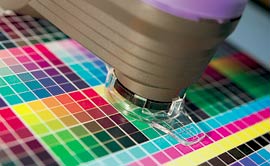Only using one ISO coated ICC profile for all coated papers?
 I guess most users of ISO 12647/2 will either use the Fogra 39 based ‘ISO coated v2” profiles from the ECI (European Color Initiative) or Adobes ‘Coated FOGRA39 (ISO 12647-2-2004)’ profile which is in the later versions of Adobe CS and used by their color settings file ‘Europe Prepress 3’.
I guess most users of ISO 12647/2 will either use the Fogra 39 based ‘ISO coated v2” profiles from the ECI (European Color Initiative) or Adobes ‘Coated FOGRA39 (ISO 12647-2-2004)’ profile which is in the later versions of Adobe CS and used by their color settings file ‘Europe Prepress 3’.
Just to mention an on-going irritation at this point. These profiles, and often printing to ISO 12647/2, are referred to as using Fogra 39! This is not correct. Fogra 39 is a colour management data set created by Fogra by printing colour management target patches to the requirements of ISO 12647/2 on coated paper, then measuring the result using colour management software to produce a colour data set. In this case called Fogra 39!
This colour management data set is freely available from the ECI web site, so anyone can use it to make an ‘ISO coated v2’ ICC profile. This is what both Adobe and the ECI have done. Fogra 39 therefore is not a standard or a ICC profile, but part of the toolset that is needed to print to the standard on coated papers.
So end of a minor rant and back to the point, do you need more then one ICC profile based on Fogra 39 for printing on coated paper for ISO 12647/2?
Yes, I believe you may. Differing images, lighter weight papers and older presses will benefit from using profiles with different TAC (Total Area Coverage) of ink and higher GCR (Grey Component Replacement) for stronger black separations.
Four colour black and white images will be more stable if an ICC profile is used with a higher GCR then the ‘standard’ ISO coated v2 profiles. Lighter weight coated papers we be more stable on press if lower TAC profiles are used. It this case less ink film weights will result is less paper stretch and deformation and quicker drying.
If presses are a little unstable or have less then optimum inking, the use of lower TAC and higher GCR, resulting in stronger black separations will make any colour variation and registration issues less noticeable.
Higher GRC and lower TAC can also reduce ink consumption, so lowering costs. Just work how much extra turnover you would need to match savings of just 5%-10% reduction in ink costs that using these profiles could give. Also using lower TAC based profiles can result in less paper deformation on light weight papers, faster drying and less marking. Also often less, or even no seal is needed.
So how to implement the use of other Fogra 39 based profiles? Well, you can download the For a 39 dataset and make your own profiles using colour management software from the usually suspects. Also a number of companies and organisations such as Basicolor and VIGC have produced such profiles, which are freely available.
Please see my blog on the VIGC profiles.
If you are unsure about the use and application of these profiles it may be best to talk to a colour management consultant. I know a good one J.
Finally, I have discussed this areas using other Fogra 39 based profiles as a basis, but of course this concept also applies to other profiles and printing conditions such as uncoated papers, and there are also profiles based on the Fogra 47 data set for whiter uncoated papers that can offer the same benefits.
Twitter
- Paul Sherfield who runs the consultancy is well known in the printing and pre-media industry as having considerable knowledge on digital workflows, with a special expertise on the business reasoning behind such systems.
He has installed some of the most successful digital pre-press and pre media systems in the UK. For 2 years he worked on a number of medium term projects before starting the consultancy in July 2000. Before this he was a partner in what became one of the leading pre-press/printing companies in London.
He is active in a number of industry groups including the BPIF Technical Standards Committee, ISO TC 130 printing standards committees and is chair of the BPIF steering group for ISO 12647/2 UK certification, He is a regular speaker at seminars and conferences.



